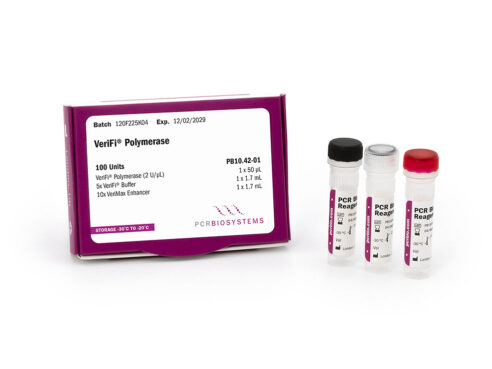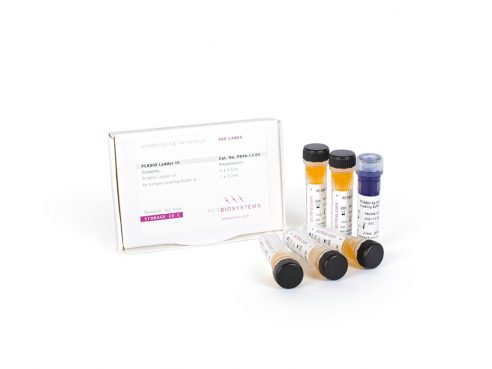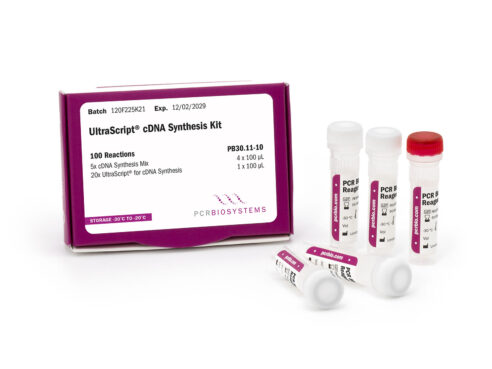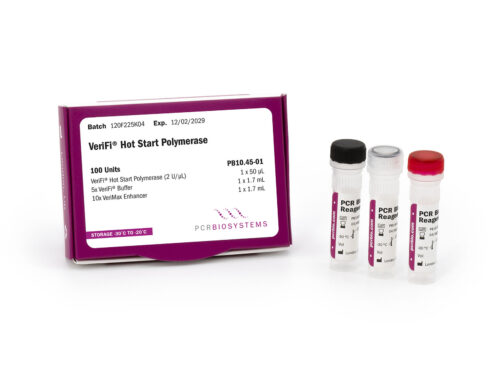PCRBIO HiFi Polymerase
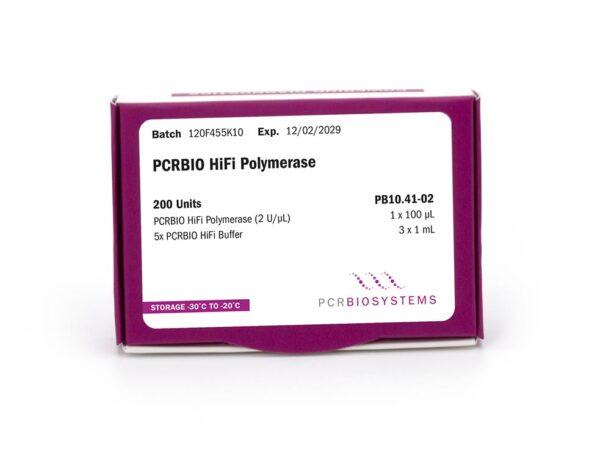
PCRBIO HiFi Polymerase is our original high-fidelity enzyme, derived from Pfu DNA polymerase for its 3’-5’ exonuclease (proofreading) activity.
Several proprietary point mutations allow for significantly improved performance when compared with its native form. Together with advanced buffer chemistry this enzyme brings robust performance to the world of high fidelity PCR. For HiFi applications we now recommend our newest proofreading polymerases, VeriFi® and VeriFi® Hot Start
PCRBIO HiFi Polymerase uses the latest developments in DNA polymerase technology and buffer chemistry to enhance PCR speed, yield and specificity. The enzyme and buffer system give superior PCR performance on complex templates such has mammalian genomic DNA. Enhanced DNA binding allows for improved processivity, increasing yield and shortening cycling times (35 cycles of a 5kb amplicon in under 1.5hours). PCRBIO HiFi Polymerase performs consistently well on a broad range of templates including both GC and AT rich.
Features
- 50x higher fidelity than Taq DNA polymerase
- Increased PCR success rates with longer amplicons
- Advanced buffer chemistry including Mg and dNTPs
- High yields under standard and fast PCR conditions
- Efficient and specific amplification from complex templates including GC rich and AT rich sequences
Applications
- High fidelity PCR
- Blunt-end cloning
- Site directed mutagenesis
- Colony PCR
- “Difficult” PCR – GC/AT rich DNA
Documents
Product Flyers
Product Manuals
Material Safety Data Sheets
Certificate of Analysis Finder
Specifications
PCRBIO HiFi Polymerase
Component
200 Units
1000 Units
PCRBIO HiFi Polymerase (2u/μl)
1 x 100μL
5 x 100μL
5x PCRBIO HiFi Buffer
3 x 1mL
15 x 1mL
PCRBIO HiFi Polymerase
Component
PCRBIO HiFi Polymerase (2u/μl)
5x PCRBIO HiFi Buffer
200 Units
1 x 100μL
3 x 1mL
1000 Units
5 x 100μL
15 x 1mL
Reaction Volume
Storage
Not applicable
On arrival, products should be stored between -30 and -20 °C. If stored correctly the kit will retain full activity until the indicated expiry date.
Reaction Volume
Not applicable
Storage
On arrival, products should be stored between -30 and -20 °C. If stored correctly the kit will retain full activity until the indicated expiry date.
FAQs
What type of cloning strategy should I use with a fragment generated using PCRBIO HiFi polymerase?
PCR products generated by PCRBIO HiFi polymerase have blunt ends, making them suitable for blunt end cloning without requiring any further modification.
If you would like to add A-overhangs, you can use Taq DNA Polymerase or Klenow (exo-) DNA followed by TA cloning1. Before proceeding with the addition of A-overhangs, ensure the PCRBIO HiFi polymerase has been removed from the reaction. If there is any PCRBIO HiFi Polymerase present, the 3’-5’ exonuclease activity of the enzyme can remove A-overhangs.
1 Yao, S., Hart, D. J. & An, Y. Recent advances in universal TA cloning methods for use in function studies. Protein Eng Des Sel, doi:10.1093/protein/gzw047 (2016).
Can PCRBIO HiFi Polymerase be used for colony PCR?
Yes. If you’re working from bacterial colonies use a sterile tip to pick a colony and re-suspend into the 50µl PCR reaction. If working from liquid culture add 5µl of overnight culture to the final mix. Follow the general protocol and increase the initial denaturation time to 10 min at 95°C.
Can PCRBIO HiFi Polymerase be used for multiplex PCR?
PCRBIO HiFi Polymerase doesn’t contain hot-start technology however it does have an intrinsically low activity at low temperatures, which are much lower relative to a Taq Polymerase without the hot start. This means it can be used for some multiplex applications.
When first performing multiplex PCR, we recommend running an annealing temperature gradient from 55°C to 65°C. The annealing temperature that results in the best specificity should be used in subsequent experiments. Fast cycling conditions should not be used for multiplex PCR. We recommend a 90 second extension time to begin with and this time may be extended to increase yield.
For multiplex reactions, the reactions should be set up on ice or cooling blocs from start till finish. Primers must be designed carefully to avoid overlapping sequences as much as possible while maintaining diverse amplicon lengths that can be easily analysed with your end-detection method1-3. Please beware of the amplicon length limitations for PCRBIO HiFi Polymerase. If one of your amplicons is near the limit consider using VeriFi® Polymerase.
1 Markoulatos, P., Siafakas, N. & Moncany, M. Multiplex polymerase chain reaction: a practical approach. J Clin Lab Anal 16, 47-51, doi:10.1002/jcla.2058 (2002).
2 Radhika, M., Saugata, M., Murali, H. S. & Batra, H. V. A novel multiplex PCR for the simultaneous detection of Salmonella enterica and Shigella species. Brazilian Journal of Microbiology 45, 667-676, doi:10.1590/s1517-83822014005000041 (2014).
3 Perez-Perez, F. J. & Hanson, N. D. Detection of plasmid-mediated AmpC beta-lactamase genes in clinical isolates by using multiplex PCR. J Clin Microbiol 40, 2153-2162, doi:10.1128/jcm.40.6.2153-2162.2002 (2002).
Can PCRBIO HiFi Polymerase proof-read?
Yes. PCRBIO HiFi Polymerase has 3’-5’ exonuclease (proofreading) activity.
What is the error rate of PCRBIO HiFi Polymerase?
PCRBIO HiFi Polymerase has an error rate of approximately 1 error per 4.5 x 107 nucleotides incorporated. This is over 50 times lower than PCRBIO Taq DNA polymerase.
What is the difference between PCRBIO HiFi Polymerase and VeriFi® Polymerase?
VeriFi® Polymerase has an enhanced processivity relative to PCRBIO HiFi Polymerase, resulting in shorter extension times (10-30 s/kb), higher yields and the ability to amplify longer (up to 17.5 kb) and more difficult targets. VeriFi® Polymerase also has a higher fidelity than PCRBIO HiFi Polymerase. Unlike PCRBIO HiFi polymerase, VeriFi® Polymerase is available as a convenient 2x ready mix with the option of a red dye for direct gel loading, saving time during reaction setup and analysis.
What is the recommended extension time for PCRBIO HiFi Polymerase?
30 seconds per kilobase (kb) is recommended for amplification from eukaryotic DNA. The extension time can be shortened for viral and bacterial DNA.
My results contain a high background of non-specific amplicons or smears. What trouble-shooting suggestions do you have?
If smears are a concern, it’s good practice to ensure they are not an artifact of running agarose gel electrophoresis with sub optimal conditions. Sub optimal conditions can include high voltage or not allowing enough time for the gel to set1.
You may also need to troubleshoot the PCR reaction and consider the suggestions and literature below2.
- Primers should be designed to prevent primer-primer interactions and improve specificity.
- Increase the annealing temperature or conducting an annealing temperature gradient PCR to determine the optimal annealing temperature.
- Reduce the amount of template in the reaction. For high quality DNA, use 1–100 ng genomic DNA or ≤5 ng plasmid/lambda DNA per 50 µL reaction.
- Reduce the number of cycles.
- Reduce the amount of enzyme per reaction.
- Reduce the primer concentration, but not lower than 100 nM of each primer.
- Include DMSO in the reaction to a final concentration of 5%–10%.
1 Koontz, L. Agarose Gel Electrophoresis. Laboratory methods in enzymology : DNA. First edition. edn, Vol. 529 35-45 (2013).
2 Lorenz, T. C. Polymerase chain reaction: basic protocol plus troubleshooting and optimization strategies. J Vis Exp, e3998, doi:10.3791/3998 (2012).
My results show a very low yield. What trouble-shooting suggestions do you have?
You may want to consider the suggestions below and also refer to the literature1.
- Optimise the annealing temperature in an annealing temperature gradient PCR.
- Increase the amount of template in the reaction.
- Increase the number of cycles.
- Increase the amount of enzyme per reaction.
- Increase the primer concentration, but do not exceed 1 µM of each primer.
- Try a fresh dNTP solution.
- Optimise the MgCl2
1 Lorenz, T. C. Polymerase chain reaction: basic protocol plus troubleshooting and optimization strategies. J Vis Exp, e3998, doi:10.3791/3998 (2012).
Can I use PCRBIO HiFi Polymerase if my assay requires a specialized buffer?
The 5x PCRBIO HiFi buffer supplied with PCRBIO HiFi Polymerase has been developed specifically for this enzyme and we highly recommend using them together. However, PCRBIO HiFi Polymerase should be compatible with any PCR buffer developed for use with Pfu polymerase. If you use a customised buffer with PCRBIO HiFi Polymerase, keep in mind reaction parameters such as annealing temperature and concentrations of the enzyme, template, dNTPs and MgCl2, may require optimisation.
PCRBIO HiFi Polymerase uses the latest developments in DNA polymerase technology and buffer chemistry to enhance PCR speed, yield and specificity. The enzyme and buffer system give superior PCR performance on complex templates such has mammalian genomic DNA. Enhanced DNA binding allows for improved processivity, increasing yield and shortening cycling times (35 cycles of a 5kb amplicon in under 1.5hours). PCRBIO HiFi Polymerase performs consistently well on a broad range of templates including both GC and AT rich.
Features
- 50x higher fidelity than Taq DNA polymerase
- Increased PCR success rates with longer amplicons
- Advanced buffer chemistry including Mg and dNTPs
- High yields under standard and fast PCR conditions
- Efficient and specific amplification from complex templates including GC rich and AT rich sequences
Applications
- High fidelity PCR
- Blunt-end cloning
- Site directed mutagenesis
- Colony PCR
- “Difficult” PCR – GC/AT rich DNA
Request a Quote & Sample
Your Selection:
Documents
Product Flyers
Product Manuals
Material Safety Data Sheets
Certificate of Analysis Finder
Specifications
PCRBIO HiFi Polymerase
Component
200 Units
1000 Units
PCRBIO HiFi Polymerase (2u/μl)
1 x 100μL
5 x 100μL
5x PCRBIO HiFi Buffer
3 x 1mL
15 x 1mL
PCRBIO HiFi Polymerase
Component
PCRBIO HiFi Polymerase (2u/μl)
5x PCRBIO HiFi Buffer
200 Units
1 x 100μL
3 x 1mL
1000 Units
5 x 100μL
15 x 1mL
Reaction Volume
Storage
Not applicable
On arrival, products should be stored between -30 and -20 °C. If stored correctly the kit will retain full activity until the indicated expiry date.
Reaction Volume
Not applicable
Storage
On arrival, products should be stored between -30 and -20 °C. If stored correctly the kit will retain full activity until the indicated expiry date.
FAQs
What type of cloning strategy should I use with a fragment generated using PCRBIO HiFi polymerase?
PCR products generated by PCRBIO HiFi polymerase have blunt ends, making them suitable for blunt end cloning without requiring any further modification.
If you would like to add A-overhangs, you can use Taq DNA Polymerase or Klenow (exo-) DNA followed by TA cloning1. Before proceeding with the addition of A-overhangs, ensure the PCRBIO HiFi polymerase has been removed from the reaction. If there is any PCRBIO HiFi Polymerase present, the 3’-5’ exonuclease activity of the enzyme can remove A-overhangs.
1 Yao, S., Hart, D. J. & An, Y. Recent advances in universal TA cloning methods for use in function studies. Protein Eng Des Sel, doi:10.1093/protein/gzw047 (2016).
Can PCRBIO HiFi Polymerase be used for colony PCR?
Yes. If you’re working from bacterial colonies use a sterile tip to pick a colony and re-suspend into the 50µl PCR reaction. If working from liquid culture add 5µl of overnight culture to the final mix. Follow the general protocol and increase the initial denaturation time to 10 min at 95°C.
Can PCRBIO HiFi Polymerase be used for multiplex PCR?
PCRBIO HiFi Polymerase doesn’t contain hot-start technology however it does have an intrinsically low activity at low temperatures, which are much lower relative to a Taq Polymerase without the hot start. This means it can be used for some multiplex applications.
When first performing multiplex PCR, we recommend running an annealing temperature gradient from 55°C to 65°C. The annealing temperature that results in the best specificity should be used in subsequent experiments. Fast cycling conditions should not be used for multiplex PCR. We recommend a 90 second extension time to begin with and this time may be extended to increase yield.
For multiplex reactions, the reactions should be set up on ice or cooling blocs from start till finish. Primers must be designed carefully to avoid overlapping sequences as much as possible while maintaining diverse amplicon lengths that can be easily analysed with your end-detection method1-3. Please beware of the amplicon length limitations for PCRBIO HiFi Polymerase. If one of your amplicons is near the limit consider using VeriFi® Polymerase.
1 Markoulatos, P., Siafakas, N. & Moncany, M. Multiplex polymerase chain reaction: a practical approach. J Clin Lab Anal 16, 47-51, doi:10.1002/jcla.2058 (2002).
2 Radhika, M., Saugata, M., Murali, H. S. & Batra, H. V. A novel multiplex PCR for the simultaneous detection of Salmonella enterica and Shigella species. Brazilian Journal of Microbiology 45, 667-676, doi:10.1590/s1517-83822014005000041 (2014).
3 Perez-Perez, F. J. & Hanson, N. D. Detection of plasmid-mediated AmpC beta-lactamase genes in clinical isolates by using multiplex PCR. J Clin Microbiol 40, 2153-2162, doi:10.1128/jcm.40.6.2153-2162.2002 (2002).
Can PCRBIO HiFi Polymerase proof-read?
Yes. PCRBIO HiFi Polymerase has 3’-5’ exonuclease (proofreading) activity.
What is the error rate of PCRBIO HiFi Polymerase?
PCRBIO HiFi Polymerase has an error rate of approximately 1 error per 4.5 x 107 nucleotides incorporated. This is over 50 times lower than PCRBIO Taq DNA polymerase.
What is the difference between PCRBIO HiFi Polymerase and VeriFi® Polymerase?
VeriFi® Polymerase has an enhanced processivity relative to PCRBIO HiFi Polymerase, resulting in shorter extension times (10-30 s/kb), higher yields and the ability to amplify longer (up to 17.5 kb) and more difficult targets. VeriFi® Polymerase also has a higher fidelity than PCRBIO HiFi Polymerase. Unlike PCRBIO HiFi polymerase, VeriFi® Polymerase is available as a convenient 2x ready mix with the option of a red dye for direct gel loading, saving time during reaction setup and analysis.
What is the recommended extension time for PCRBIO HiFi Polymerase?
30 seconds per kilobase (kb) is recommended for amplification from eukaryotic DNA. The extension time can be shortened for viral and bacterial DNA.
My results contain a high background of non-specific amplicons or smears. What trouble-shooting suggestions do you have?
If smears are a concern, it’s good practice to ensure they are not an artifact of running agarose gel electrophoresis with sub optimal conditions. Sub optimal conditions can include high voltage or not allowing enough time for the gel to set1.
You may also need to troubleshoot the PCR reaction and consider the suggestions and literature below2.
- Primers should be designed to prevent primer-primer interactions and improve specificity.
- Increase the annealing temperature or conducting an annealing temperature gradient PCR to determine the optimal annealing temperature.
- Reduce the amount of template in the reaction. For high quality DNA, use 1–100 ng genomic DNA or ≤5 ng plasmid/lambda DNA per 50 µL reaction.
- Reduce the number of cycles.
- Reduce the amount of enzyme per reaction.
- Reduce the primer concentration, but not lower than 100 nM of each primer.
- Include DMSO in the reaction to a final concentration of 5%–10%.
1 Koontz, L. Agarose Gel Electrophoresis. Laboratory methods in enzymology : DNA. First edition. edn, Vol. 529 35-45 (2013).
2 Lorenz, T. C. Polymerase chain reaction: basic protocol plus troubleshooting and optimization strategies. J Vis Exp, e3998, doi:10.3791/3998 (2012).
My results show a very low yield. What trouble-shooting suggestions do you have?
You may want to consider the suggestions below and also refer to the literature1.
- Optimise the annealing temperature in an annealing temperature gradient PCR.
- Increase the amount of template in the reaction.
- Increase the number of cycles.
- Increase the amount of enzyme per reaction.
- Increase the primer concentration, but do not exceed 1 µM of each primer.
- Try a fresh dNTP solution.
- Optimise the MgCl2
1 Lorenz, T. C. Polymerase chain reaction: basic protocol plus troubleshooting and optimization strategies. J Vis Exp, e3998, doi:10.3791/3998 (2012).
Can I use PCRBIO HiFi Polymerase if my assay requires a specialized buffer?
The 5x PCRBIO HiFi buffer supplied with PCRBIO HiFi Polymerase has been developed specifically for this enzyme and we highly recommend using them together. However, PCRBIO HiFi Polymerase should be compatible with any PCR buffer developed for use with Pfu polymerase. If you use a customised buffer with PCRBIO HiFi Polymerase, keep in mind reaction parameters such as annealing temperature and concentrations of the enzyme, template, dNTPs and MgCl2, may require optimisation.




